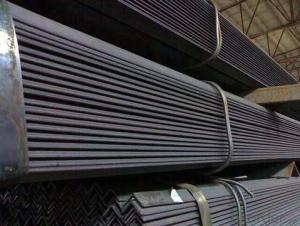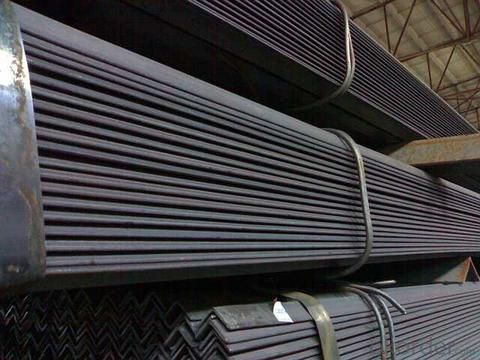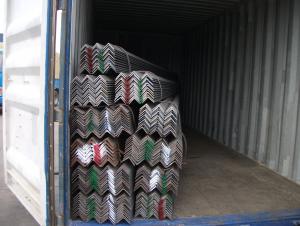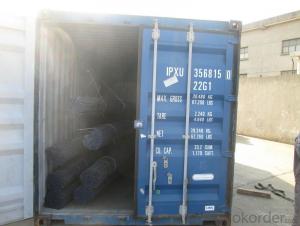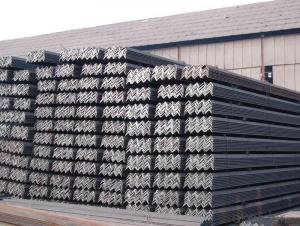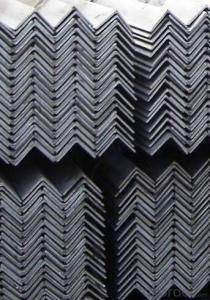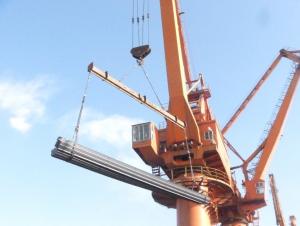SS400 Material High Quality Angle Bar
- Loading Port:
- Tianjin
- Payment Terms:
- TT or LC
- Min Order Qty:
- 25 m.t.
- Supply Capability:
- 2000 m.t./month
OKorder Service Pledge
OKorder Financial Service
You Might Also Like
Product Description:
OKorder is offering Angle Steel great prices with worldwide shipping. Our supplier is a world-class manufacturer of steel, with our products utilized the world over. OKorder annually supplies products to European, North American and Asian markets. We provide quotations within 24 hours of receiving an inquiry and guarantee competitive prices.
Product Applications:
According to the needs of different structures, Angle can compose to different force support component, and also can be the connections between components. It is widely used in various building structures and engineering structures such as roof beams, bridges, transmission towers, hoisting machinery and transport machinery, ships, industrial furnaces, reaction tower, container frame and warehouse etc.
Product Advantages:
OKorder's Angle Steelare durable, strong, and resist corrosion.
Main Product Features:
· Premium quality
· Prompt delivery & seaworthy packing (30 days after receiving deposit)
· Corrosion resistance
· Can be recycled and reused
· Mill test certification
· Professional Service
· Competitive pricing
Product Specifications:
1. Invoicing on theoretical weight or actual weight as customer request
2. Length: 6m, 9m, 12m as following table
3. Sizes
Sizes: 25mm-250mm | ||
a*t | ||
25*2.5-4.0 | 70*6.0-9.0 | 130*9.0-15 |
30*2.5-6.6 | 75*6.0-9.0 | 140*10-14 |
36*3.0-5.0 | 80*5.0-10 | 150*10-20 |
38*2.3-6.0 | 90*7.0-10 | 160*10-16 |
40*3.0-5.0 | 100*6.0-12 | 175*12-15 |
45*4.0-6.0 | 110*8.0-10 | 180*12-18 |
50*4.0-6.0 | 120*6.0-15 | 200*14-25 |
60*4.0-8.0 | 125*8.0-14 | 250*25 |
Alloy No | Grade | Element (%) | |||||
C | Mn | S | P | Si | |||
|
|
|
|
|
|
| |
Q235 | B | 0.12—0.20 | 0.3—0.7 | ≤0.045 | ≤0.045 | ≤0.3 | |
|
|
|
|
|
|
| |
Alloy No | Grade | Yielding strength point( Mpa) | |||||
Thickness (mm) | |||||||
≤16 | >16--40 | >40--60 | >60--100 | ||||
≥ | |||||||
|
|
|
|
|
| ||
Q235 | B | 235 | 225 | 215 | 205 | ||
Alloy No | Grade | Tensile strength (Mpa) | Elongation after fracture (%) | ||||
Thickness (mm) | |||||||
| ≤16 | >16--40 | >40--60 | >60--100 | |||
≥ | |||||||
|
|
|
|
|
|
| |
Q235 | B | 375--500 | 26 | 25 | 24 | 23 | |
Packaging & Delivery of Angle Bar
Packaging Detail: All goods are packed in bundle with steel strips and shipped by break bulk vessel or container (depend on target market and different ports)
Delivery Detail: 45 days
Trade terms: FOB, CFR, CIF
Payment:
-Invoicing on theoretical weight or actual weight as customer’s request.
-FOB, CFR or CIF.
-Regular terms of payment:
1, 30% payment in advance, the remaining balance (70% payment) against the copy of B/L. 100% payment before shipment.
2, 30% payment in advance, the remaining balance (70% L/C) against the copy of B/L. 100% payment before shipment.
3, Negotiable.
FAQ:
Q1 How soon can we receive the product after purchase?
A1 Within three days of placing an order, we will begin production. The specific shipping date is dependent upon international and government factors, but is typically 7 to 10 workdays.
Q2: How do we guarantee the quality of our products?
A2: We have established an advanced quality management system which conducts strict quality tests at every step, from raw materials to the final product. At the same time, we provide extensive follow-up service assurances as required.
Q3: How soon can we receive the product after purchase?
A3: Within three days of placing an order, we will begin production. The specific shipping date is dependent upon international and government factors, but is typically 7 to 10 workdays.
Images:
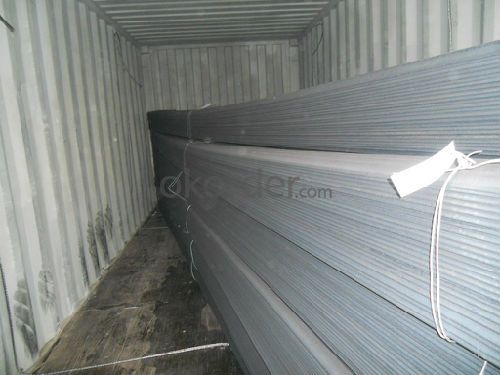
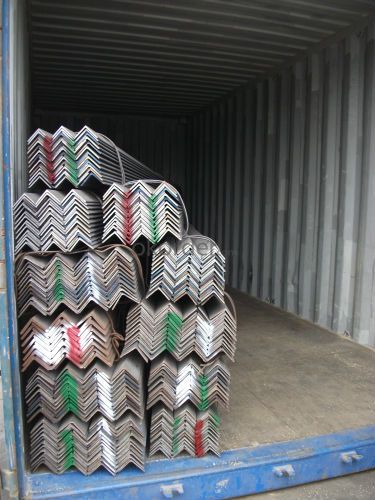
- Q: Can steel angles be used for soundproofing applications?
- Soundproofing applications typically do not involve the use of steel angles. When selecting soundproofing materials, their ability to absorb, dampen, or block sound waves is considered. Steel angles, being rigid and reflective, lack these sound-dampening qualities. Instead, acoustic foam, mass-loaded vinyl, or soundproof drywall are commonly chosen for soundproofing. These materials are specifically designed to absorb or block sound waves, reducing noise transmission between spaces. Consequently, although steel angles have diverse applications in construction and engineering, they are unsuitable for soundproofing purposes.
- Q: What is the meaning of the number of angle steel
- The two sides of an equal angle steel are equal in width. The specifications are expressed in millimeters of edge width * edge width * edge thickness. Such as "/ 30 x 30 x 3", that is 30 mm width equal angle, edge thickness of 3 mm. The model can also be used, also the title number, number is the number of centimeters wide, such as the No. 3 angle angle 3#.
- Q: What is the maximum length of a continuous steel angle?
- Several factors determine the maximum length of a continuous steel angle, including its size, weight, transportation and handling limitations. Typically, the maximum length is restricted to what can be safely transported and handled by equipment like cranes or forklifts. This limit can vary based on the capabilities of the equipment and any transportation restrictions. The manufacturing process may also limit the length, as longer angles may be more challenging to produce or require specialized equipment. Ultimately, the maximum length should be determined based on the project's specific requirements and constraints, taking into account these factors.
- Q: Are steel angles suitable for scaffolding?
- Yes, steel angles are suitable for scaffolding. They are commonly used in scaffolding systems due to their strength, durability, and ability to provide stable support for workers and materials. Steel angles offer excellent load-bearing capacity and can withstand heavy loads, making them a reliable choice for scaffolding structures.
- Q: How do you prevent rust on steel angles?
- To prevent rust on steel angles, there are several steps you can take: 1. Apply a protective coating: One of the most effective ways to prevent rust is to apply a protective coating on the steel angles. This can be done using paint, varnish, or other corrosion-resistant coatings. Make sure to choose a coating that is specifically designed for preventing rust on steel surfaces. 2. Use galvanized steel angles: Galvanization is a process where a layer of zinc is applied to the steel, providing a protective barrier against rust. Using galvanized steel angles can significantly reduce the risk of rust formation. These angles are readily available in the market and are a popular choice for outdoor applications. 3. Keep moisture away: Rust formation is accelerated by moisture, so it is crucial to keep steel angles dry. Avoid exposing them to rain, humid environments, or excessive moisture. If the angles are installed outdoors, ensure proper drainage and provide adequate ventilation to prevent the buildup of moisture. 4. Regular cleaning and maintenance: Regularly cleaning the steel angles will help remove any dirt, dust, or other contaminants that can contribute to rust formation. Use a mild detergent or cleaning solution and a soft cloth or sponge to clean the surface. After cleaning, make sure the angles are completely dry before applying any protective coating. 5. Monitor and repair damaged coatings: Over time, protective coatings may get damaged due to wear and tear or exposure to harsh conditions. It is essential to monitor the condition of the coatings and repair any damaged areas promptly. This will help maintain the integrity of the protective layer and prevent rust from forming. 6. Consider using stainless steel angles: Stainless steel is highly resistant to rust and corrosion due to its chromium content. If rust prevention is a top priority, you may consider using stainless steel angles instead of regular steel. Although stainless steel angles are typically more expensive, they offer superior durability and a longer lifespan. By implementing these preventive measures, you can significantly reduce the risk of rust formation on steel angles, ensuring their longevity and maintaining their structural integrity.
- Q: What are the different types of corrosion protection coatings for steel angles?
- There are several types of corrosion protection coatings available for steel angles, each designed to provide varying levels of protection against corrosion. 1. Paint Coatings: One of the most common types of corrosion protection coatings for steel angles is paint. Paint coatings act as a barrier between the steel surface and the corrosive elements in the environment. They are usually applied in multiple layers and can be customized to meet specific requirements, such as resistance to chemicals or UV radiation. 2. Galvanizing: Galvanizing is another widely used corrosion protection method for steel angles. It involves applying a layer of zinc to the steel surface through a process called hot-dip galvanizing. This coating provides excellent protection against corrosion as the zinc layer acts as a sacrificial anode, corroding before the steel does. Galvanized steel angles are commonly used in outdoor applications where they may be exposed to moisture and harsh weather conditions. 3. Powder Coatings: Powder coatings are a type of protective coating that is applied as a dry powder and then cured using heat. They provide a durable and corrosion-resistant finish to steel angles. Powder coatings can be customized in terms of color, texture, and thickness, offering both aesthetic appeal and enhanced protection against corrosion. 4. Epoxy Coatings: Epoxy coatings are often used for industrial applications where steel angles may be exposed to harsh chemicals or abrasive environments. These coatings form a strong, protective layer that resists corrosion, as well as chemicals, solvents, and abrasion. Epoxy coatings can be applied as a single layer or in combination with other coatings for added protection. 5. Organic Coatings: Organic coatings, such as polyurethane or acrylic coatings, are commonly used in architectural applications where steel angles require protection from corrosion while maintaining an aesthetically pleasing appearance. These coatings provide good resistance to weathering, UV radiation, and corrosion, ensuring the longevity of the steel angles. It is important to consider the specific application, environmental conditions, and budget constraints when selecting a corrosion protection coating for steel angles. Consulting with a corrosion specialist or coating supplier can help determine the most suitable coating for the intended use.
- Q: Can steel angles be used as supports for mechanical or HVAC ducts?
- Yes, steel angles can be used as supports for mechanical or HVAC ducts. Steel angles provide a strong and durable framework to securely hold and provide stability to the ductwork.
- Q: What is angle flower? Is it the same as angle iron?
- I'm here to tell you that the angle iron is the common name of galvanized steel bar, so the difference between the angle iron and the angle iron is that the surface is made of zinc coating. Angle iron is generally used for electrical installations.
- Q: Can steel angles be used for vehicle frames?
- Yes, steel angles can be used for vehicle frames. Steel angles are commonly used in the construction industry for their structural strength and versatility. They have a wide range of applications, including the construction of vehicle frames. Steel angles provide excellent support and stability, making them ideal for bearing heavy loads and withstanding the various stresses and forces experienced by a vehicle during operation. Additionally, steel angles can be easily welded or bolted together, allowing for flexibility in the design and construction of vehicle frames. Overall, steel angles are a reliable and durable choice for vehicle frames, ensuring the structural integrity and safety of the vehicle.
- Q: Can steel angles be used in playground or recreational equipment?
- Absolutely! Playground or recreational equipment can definitely make use of steel angles. Steel angles are incredibly versatile and sturdy as a structural material, making them perfect for a wide range of purposes in playground or recreational equipment. They offer stability, support, and long-lasting durability, which makes them ideal for use in various structures like climbing frames, swing sets, slides, and other equipment. Given their ability to withstand heavy loads, impact forces, and even harsh weather conditions, steel angles are often used to create frames, posts, and supports in playground equipment. What's great is that these angles can be easily customized and fabricated to meet specific design requirements, ensuring that the equipment is both safe and functional.
Send your message to us
SS400 Material High Quality Angle Bar
- Loading Port:
- Tianjin
- Payment Terms:
- TT or LC
- Min Order Qty:
- 25 m.t.
- Supply Capability:
- 2000 m.t./month
OKorder Service Pledge
OKorder Financial Service
Similar products
Hot products
Hot Searches


